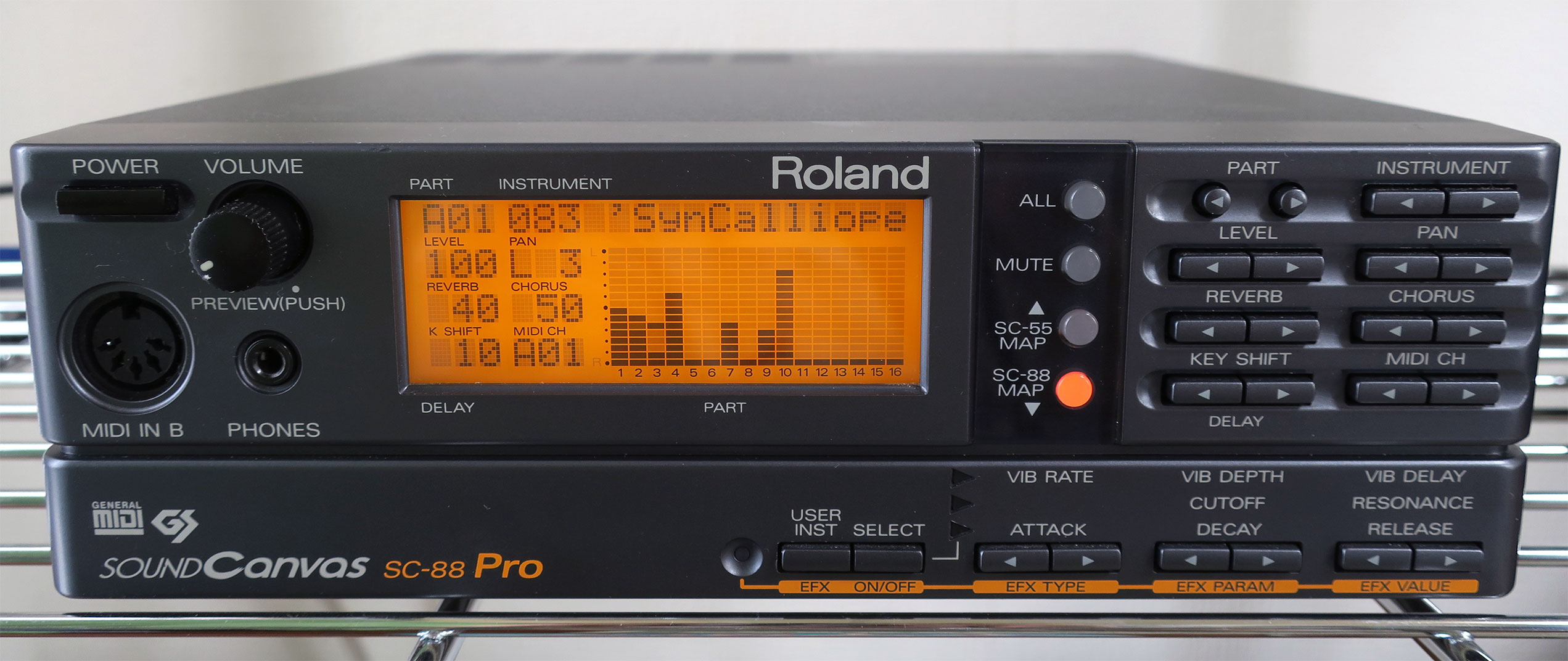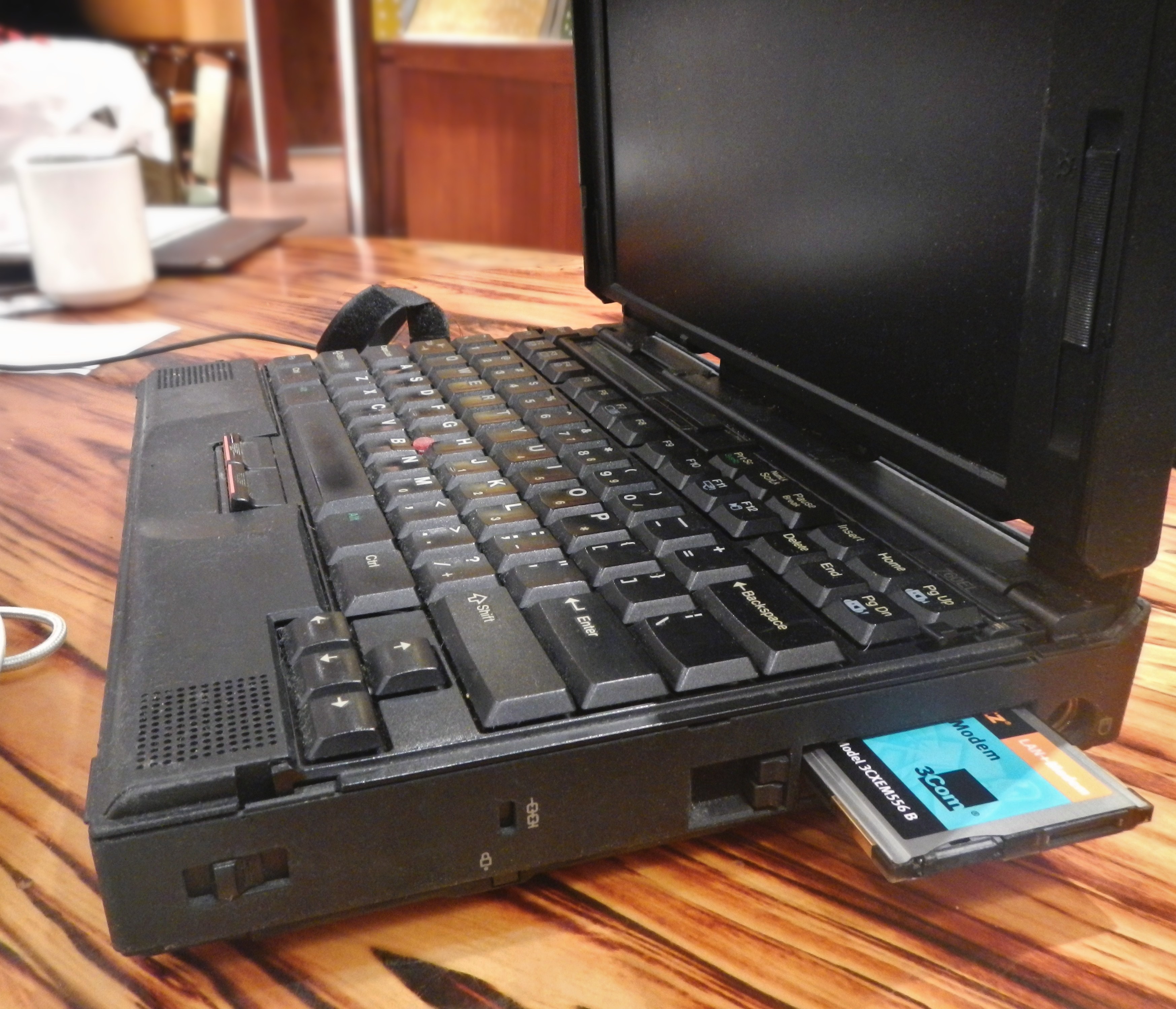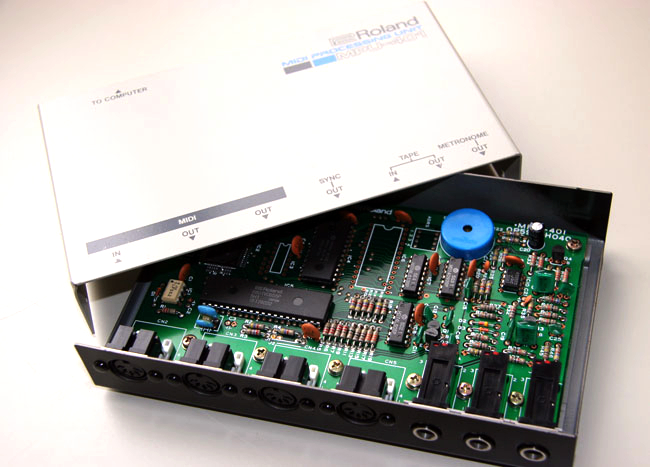|
Roland Sound Canvas
Roland/Edirol Sound Canvas lineup is a series of General MIDI (GM) based pulse-code modulation (PCM) sound modules and sound cards, primarily intended for computer music usage, created by Japanese manufacturer Roland Corporation. Some models include a serial or USB connection, to a personal computer. Products Sound Canvas In some cases also sold as "Edirol" rather than "Roland" as the brand name. Sound Canvas Personal Computer Products Computer Music Products Sound Canvas and Keyboard The following combine a sound canvas module with a built in MIDI keyboard Edirol Roland sold GM/GS products under its Edirol brand. The samples contained in the ROMs of these units do not in all cases mirror the original SC-7 / SC-55 GM/GS samples. GM2 is downward compatible with GM. The SD line was also sold under the "Roland" brand. Virtual Sound Canvas There is also the VSC, Virtual Sound Canvas, range of PC software which provide GM and GS synthesis on Windows PCs. Many ver ... [...More Info...] [...Related Items...] OR: [Wikipedia] [Google] [Baidu] |
General MIDI
General MIDI (also known as GM or GM 1) is a standardized specification for electronic musical instruments that respond to MIDI messages. GM was developed by the American MIDI Manufacturers Association (MMA) and the Japan MIDI Standards Committee (JMSC) and first published in 1991. The official specification is available in English from the MMA, bound together with the MIDI 1.0 specification, and in Japanese from the Association of Musical Electronic Industry (AMEI). GM imposes several requirements beyond the more abstract MIDI 1.0 specification. While MIDI 1.0 by itself provides a communications protocol which ensures that different instruments can interoperate at a fundamental level — for example, that pressing keys on a MIDI keyboard will cause an attached MIDI sound module to play musical notes — GM goes further in two ways. First, GM requires that all compliant MIDI instruments meet a certain minimal set of features, such as being able to play at least 24 notes simultan ... [...More Info...] [...Related Items...] OR: [Wikipedia] [Google] [Baidu] |
General MIDI 2
General MIDI Level 2 or GM2 is a specification for synthesizers which defines several requirements beyond the more abstract MIDI standard and is based on General MIDI and GS extensions. It was adopted in 1999 by the MIDI Manufacturers Association (MMA). General requirements * Number of Notes: 32 simultaneous notes * MIDI Channels: 16 * Simultaneous Melodic Instruments – up to 16 (all Channels) * Simultaneous Percussion Kits – up to 2 (Channel 10/11) Parameters Program and bank change events General MIDI 2 compatible synthesizers access all of the 256 instruments by setting cc#0 (Bank Select MSB) to 121 and using cc#32 (Bank Select LSB) to select the variation bank before a Program Change. Variation bank 0 contains the full GM — that is, General MIDI 1 — sound set. Variations using other bank numbers are new to General MIDI 2, and correspond to variation sounds introduced in Roland GS. Melodic sounds = Piano = = Chromatic Percussion = = Organ = = Guitar = = Bass ... [...More Info...] [...Related Items...] OR: [Wikipedia] [Google] [Baidu] |
DirectX Plugin
In computer music and professional audio creation, a DirectX plugin is a software processing component that can be loaded as a plugin into ''host applications'' to allow real-time processing, audio effects, mixing audio or act as virtual synthesizers. DirectX plugins allow the replacement of traditional recording studio hardware and rack units used in professional studios with software-based counterparts that can be connected together in a modular way. This allows host manufacturers to focus on the conviviality and efficiency of their products while specialized manufacturers can focus on the digital signal processing aspect. For example, there are plugins for effects boxes, such as reverbs and delays, effects pedals, like guitar distortion, flange and chorus, and for mixing and mastering processors such as compressors, limiters, exciters, sub bass enhancers, stereo imagers and many more. Overview Similar to Virtual Studio Technology and later, Audio Units in Apple Mac OS X, D ... [...More Info...] [...Related Items...] OR: [Wikipedia] [Google] [Baidu] |
Cakewalk Sonar
Sonar was a digital audio workstation created by the former Boston, Massachusetts-based music production software company Cakewalk (company), Cakewalk. It was acquired by Singaporean music company BandLab Technologies and renamed Cakewalk by BandLab. Notable features Sonar's features included: * Record and manipulate an amount of multitrack digital audio limited by hardware only * Record and manipulate MIDI composition, MIDI data * Apply any DirectX special effects, such as reverberation and delay * Automate the process of Audio mixing (recorded music), mixing audio * Use virtual instruments, such as software: synthesizers, samplers, and drum machines * Connect to other multimedia applications via Rewire * Some versions included a 64-bit mastering suite Video and audio formats Sonar provided limited facilities for video, surround sound (5.1, 7.1), and supported .avi, .mpeg, .wmv, and .mov files. Sonar had the ability to show videos as thumbnails contained in a separate track. ... [...More Info...] [...Related Items...] OR: [Wikipedia] [Google] [Baidu] |
Cakewalk (company)
Cakewalk, Inc. is a former music production software company based in Boston, Massachusetts and currently a brand of Singaporean music company BandLab Technologies. The company's best known product was their professional-level digital audio workstation (DAW) software, SONAR. SONAR integrated multi-track recording and editing of digital audio and MIDI. The company also offered a full range of music software products, including Pyro Audio Creator—a digital music management program, and Dimension Pro—a virtual instrument. The brand was acquired in 2013 by Gibson, and in 2017 Gibson announced it was ceasing Cakewalk development. In 2018, Singapore-based BandLab Technologies purchased some of Cakewalk, Inc.'s assets, and continued SONAR development as part of its portfolio of freeware digital audio workstation software. History Greg Hendershott founded the company in 1987 as ''Twelve Tone Systems, Inc.'', and was its CEO until July 1, 2012. The firm soon found that most custo ... [...More Info...] [...Related Items...] OR: [Wikipedia] [Google] [Baidu] |
Hyper Canvas And TTS-1
Hyper may refer to: Arts and entertainment * ''Hyper'' (2016 film), 2016 Indian Telugu film * ''Hyper'' (2018 film), 2018 Indian Kannada film * ''Hyper'' (magazine), an Australian video game magazine *Hyper (TV channel), a Filipino sports channel * Hyper+, a former Polish programming block on Teletoon+ Mathematics *Hypercube, the n-dimensional analogue of a square and a cube *Hyperoperation, an arithmetic operation beyond exponentiation *Hyperplane, a subspace whose dimension is one less than that of its ambient space *Hypersphere, the set of points at a constant distance from a given point called its centre *Hypersurface, a generalization of the concepts of hyperplane, plane curve, and surface *Hyperstructure, an algebraic structure equipped with at least one multivalued operation *Hyperbolic functions, analogues of trigonometric functions defined using the hyperbola rather than the circle Other uses *DJ Hyper (born 1977), a British electronic musician *Hyper key, a modifier ke ... [...More Info...] [...Related Items...] OR: [Wikipedia] [Google] [Baidu] |
Roland MT-32
The Roland MT-32 Multi-Timbre Sound Module is a MIDI synthesizer module first released in 1987 by Roland Corporation. It was originally marketed to amateur musicians as a budget external synthesizer with an original list price of $695. However, it became more famous along with its compatible modules as an early ''de facto'' standard in computer music. Since it was made prior to the release of the General MIDI standard, it uses its own proprietary format for MIDI file playback. Within Roland's family of Linear Arithmetic (LA) synthesizers, the multitimbral MT-32 series constitutes the budget prosumer line for computer music at home, the multitimbral D-5, D-10, D-20 and D-110 models constitute the professional line for general studio use, and the high-end monotimbral D-50 and D-550 models are for sophisticated multi-track studio work. It was the first product in Roland's line of Desktop Music System (DTM) packages in Japan. Features Like the Roland D-50 Linear Synthesizer, ... [...More Info...] [...Related Items...] OR: [Wikipedia] [Google] [Baidu] |
NEC PC-9801
The , commonly shortened to PC-98 or , is a lineup of Japanese 16-bit and 32-bit personal computers manufactured by NEC from 1982 to 2000. The platform established NEC's dominance in the Japanese personal computer market, and, by 1999, more than 18 million units had been sold. While NEC did not market these specific machines in the West, it sold the NEC APC series, which had similar hardware to early PC-98 models. The PC-98 was initially released as a business-oriented personal computer which had backward compatibility with the successful PC-8800 series. The range of the series has expanded, and in the 1990s it was used in a variety of industry fields including education and hobbies. NEC succeeded in attracting third-party suppliers and a wide range of users, and the PC-98 dominated the Japanese PC market with more than 60% market share by 1991. IBM clones lacked sufficient graphics capabilities to easily handle Japan's multiple writing systems, in particular kanji with its tho ... [...More Info...] [...Related Items...] OR: [Wikipedia] [Google] [Baidu] |
PCMCIA
The Personal Computer Memory Card International Association (PCMCIA) was a group of computer hardware manufacturers, operating under that name from 1989 to 2009. Starting with the PCMCIA card in 1990 (the name later simplified to ''PC Card''), it created various standards for peripheral interfaces designed for laptop computers. History The PCMCIA (Personal Computer Memory Card International Association) industry organization was based on the original initiative of the British mathematician and computer scientist Ian H. S. Cullimore, one of the founders of the Sunnyvale-based Poqet Computer Corporation, who was seeking to integrate some kind of memory card technology as storage medium into their early DOS-based palmtop PCs, when traditional floppy drives and harddisks were found to be too power-hungry and large to fit into their battery-powered handheld devices. When in July 1989, Poqet contacted Fujitsu for their existing but still non-standardized SRAM memory cards, and Intel ... [...More Info...] [...Related Items...] OR: [Wikipedia] [Google] [Baidu] |
MPU-401
The MPU-401, where ''MPU'' stands for MIDI Processing Unit, is an important but now obsolete interface for connecting MIDI-equipped electronic music hardware to personal computers. It was designed by Roland Corporation, which also co-authored the MIDI standard. Design Released around 1984, the original MPU-401 was an external breakout box providing MIDI IN/MIDI OUT/MIDI THRU/TAPE IN/TAPE OUT/MIDI SYNC connectors, for use with a separately-sold interface card/cartridge ("MPU-401 interface kit") inserted into a computer system. For this setup, the following "interface kits" were made: * MIF-APL: For the Apple II. * MIF-C64: For the Commodore 64. * MIF-FM7: For the Fujitsu FM7. * MIF-IPC: For the IBM PC/IBM XT. It turned out not to work reliably with 286 and faster processors. Early versions of the actual PCB had IF-MIDI/IBM as a silk screen. * MIF-IPC-A: For the IBM AT, works with PC and XT as well. * Xanadu MUSICOM IFM-PC: For the IBM PC / IBM XT / IBM AT. This was a third party ... [...More Info...] [...Related Items...] OR: [Wikipedia] [Google] [Baidu] |
Creative Wave Blaster
The Wave Blaster was an add-on MIDI-synthesizer for Creative Sound Blaster 16 and Sound Blaster AWE32 family of PC soundcards. It was a sample-based synthesis General MIDI compliant synthesizer. For General MIDI scores, the Wave Blaster's wavetable-engine produced more realistic instrumental music than the SB16's onboard Yamaha-OPL3. The Wave Blaster attached to a SB16 through a 26-pin expansion-header, eliminating the need for extra cabling between the SB16 and the Wave Blaster. The SB16 emulated an MPU-401 UART, giving existing MIDI-software the option to send MIDI-sequences directly to the attached Wave Blaster, instead of driving an external MIDI-device. The Wave Blaster's analog stereo-output fed into a dedicated line-in on the SB16, where the onboard-mixer allowed equalization, mixing, and volume adjustment. The Wave Blaster port was adopted by other sound card manufacturers who produced both daughterboards and soundcards with the expansion-header: Diamond, Ensoni ... [...More Info...] [...Related Items...] OR: [Wikipedia] [Google] [Baidu] |
Daughter Board
In computing, an expansion card (also called an expansion board, adapter card, peripheral card or accessory card) is a printed circuit board that can be inserted into an electrical connector, or expansion slot (also referred to as a bus slot) on a computer's motherboard (see also backplane) to add functionality to a computer system. Sometimes the design of the computer's case and motherboard involves placing most (or all) of these slots onto a separate, removable card. Typically such cards are referred to as a riser card in part because they project upward from the board and allow expansion cards to be placed above and parallel to the motherboard. Expansion cards allow the capabilities and interfaces of a computer system to be extended or supplemented in a way appropriate to the tasks it will perform. For example, a high-speed multi-channel data acquisition system would be of no use in a personal computer used for bookkeeping, but might be a key part of a system used for ind ... [...More Info...] [...Related Items...] OR: [Wikipedia] [Google] [Baidu] |





